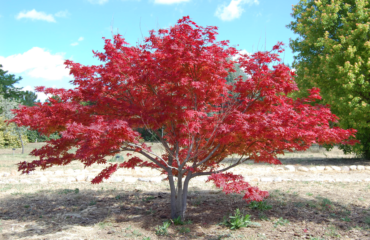Amaryllis belladonna, commonly known as the Belladonna Lily or Naked Lady, is a perennial bulbous plant native to South Africa. It is renowned for its striking, trumpet-shaped pink flowers that appear on tall, leafless stalks in late summer to early autumn. The leaves emerge after the flowers fade, hence the nickname “Naked Lady” because the blooms appear on bare stems. This plant is cherished for its dramatic flowering display and its ability to thrive in a variety of garden settings.
Preferred Growing Conditions:
- Soil Type: Prefers well-drained, sandy or loamy soil with moderate fertility.
- Sunlight: Thrives in full sun to partial shade; best flowering occurs with at least 6 hours of direct sunlight.
- Temperature: Hardy in USDA zones 7-10; prefers warm climates and can tolerate drought once established.
- Water Needs: Low to moderate; requires minimal water during its dormant phase and regular watering during the growing season.
Amaryllis Belladonna (Belladonna Lily) Propagation Methods:
1. Bulb Division:
Dividing bulbs is the most common and effective method for propagating Amaryllis belladonna. This method helps to rejuvenate the parent plant and produce new bulbs that can be planted separately.
- Timing:
- Best done in late summer or early autumn after the flowering period has ended and before the foliage begins to appear.
- Method:
- Carefully dig up the entire clump of bulbs, being cautious not to damage the bulbs or their delicate roots.
- Shake off excess soil to expose the bulbs and the offsets (smaller bulbs attached to the parent bulb).
- Gently separate the offsets from the parent bulb. Use a clean, sharp knife if necessary to cut them apart, ensuring each offset has a portion of the basal plate (the flat base of the bulb where roots grow).
- Replanting:
- Replant the parent bulb and the offsets immediately in well-prepared soil.
- Plant bulbs at a depth where the top third of the bulb is exposed above the soil surface.
- Space bulbs 12-18 inches apart to allow room for growth and future divisions.
- Water thoroughly to settle the soil around the bulbs.
- Care After Division:
- Keep the newly planted bulbs well-watered but not waterlogged.
- Mulch around the base to retain soil moisture and regulate temperature.
- Protect from extreme weather conditions and provide a sunny location for optimal growth.
2. Seed Propagation:
Growing Amaryllis belladonna from seeds is less common and more time-consuming but can be rewarding for those interested in cultivating new plants from scratch. Seed-grown plants can take several years to reach flowering maturity.
- Seed Collection and Preparation:
- Collect seeds from mature flower heads once the seed pods have dried and turned brown.
- Carefully open the pods to release the seeds. The seeds of Amaryllis belladonna are typically flat and black.
- Clean and dry the seeds for a few days in a cool, dry place before planting.
- Sowing Techniques:
- Fill seed trays or small pots with a well-draining seed-starting mix.
- Sow the seeds on the surface of the soil and lightly press them in without covering, as they need light to germinate.
- Mist the soil surface lightly and cover with a clear plastic lid or plastic wrap to maintain humidity.
- Place the trays in a bright, warm location with temperatures around 70-75°F (21-24°C).
- Germination Requirements:
- Seeds typically germinate within 2-4 weeks under optimal conditions.
- Once seedlings emerge, remove the cover to provide better air circulation.
- Keep the soil slightly moist and provide bright, indirect light to prevent leggy growth.
- Transplant seedlings into individual pots when they are large enough to handle and have developed a few true leaves.
3. Bulbils (Bulb Offsets):
Bulbils are small bulbs that sometimes form on the flower stalk or at the base of the parent bulb. These can be used to propagate new plants, though it may take a few years for them to reach flowering size.
- Collection and Preparation:
- Collect bulbils from the flower stalks after the flowering period or from the base of the bulb during the dormant season.
- Allow the bulbils to dry for a few days before planting.
- Planting:
- Plant the bulbils in small pots or directly in the garden with a well-draining soil mix.
- Plant at a depth where the top of the bulbil is just below the soil surface.
- Water lightly after planting to settle the soil.
- Growth:
- Bulbils will develop roots and shoots over time, and can be treated similarly to seedlings.
- It may take several years for the bulbils to grow large enough to produce flowers.
4. Tissue Culture:
Tissue culture is an advanced propagation method used mainly in commercial settings to produce large numbers of plants quickly. This method involves growing plant tissues in a sterile, controlled environment.
- Process:
- Small pieces of plant tissue, typically from the growing tips or meristem, are sterilized and placed in a nutrient-rich, sterile medium.
- Under controlled conditions, the tissue forms a callus, which then differentiates into shoots and roots.
- Once the plantlets are large enough, they are transferred to soil or a suitable growing medium to acclimate to normal growing conditions.
- Advantages:
- Produces a large number of uniform plants quickly.
- Can propagate disease-free plants and maintain rare or desired characteristics.
Care for Newly Propagated Plants:
- Ensure that newly planted bulbs or offsets are placed in a sunny location with well-draining soil.
- Water regularly during the growing season, but reduce watering during dormancy.
- Protect from frost and extreme temperature fluctuations, especially during the winter months.
- Apply a balanced, slow-release fertilizer in spring to encourage strong growth and flowering.
Common Challenges and Solutions:
- Fungal Diseases: Ensure good air circulation around plants and avoid waterlogging. Use fungicides as needed to control fungal issues.
- Pests: Watch for slugs, snails, and aphids, which can damage the leaves and flowers. Use appropriate pest control measures to manage infestations.
- Poor Flowering: Ensure the plant receives enough sunlight and avoid overcrowding. Bulbs may need to be divided if they become too crowded or stop flowering well.
Additional Tips:
- Mulch around the base of the plants to retain moisture and suppress weeds.
- Deadhead spent flowers to prevent seed formation and encourage energy to go back into the bulb.
- Allow the foliage to die back naturally after flowering to replenish the bulb for the next season.
- Plant in clusters or groups for a more dramatic display of blooms.
Propagating Amaryllis belladonna can be a delightful experience, providing an opportunity to expand your garden with these beautiful and striking blooms. Whether you choose to divide bulbs, grow from seeds, or use offsets, with the right care and attention, these plants will thrive and bring long-lasting beauty to your landscape.
Share this article



